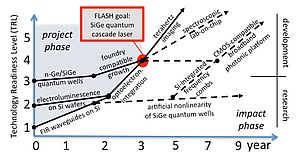This project aims at developing a cheap, compact, and high performance photonic platform compatible with mainstream Si-CMOS technology operating in the 1-10 THz range. By addressing significant material science challenges with innovative experimental and theoretical approaches, we will demonstrate two key components of the platform, i.e. the integrated source and low loss waveguides. As a light source, we will develop a quantum cascade laser based on electronic transitions occurring in the conduction band of Ge-rich GeSi/Ge quantum heterostructures.
The proposed technology would be a game changer for many of the proposed and developed THz applications where the potential mass market requires sources at the €100 -1000 price level rather than the now typical €50k-100k. The cheap & practical THz platform proposed could enable the wide-scale deployment of THz systems for healthcare, security imaging, non-destructive test, & high speed telecoms systems. Indeed, the THz part of the electromagnetic spectrum has a number of potential applications which include oncology (skin cancer imaging[i],[ii]for early stage detection), security imaging[iii](explosive detection), THz bandwidth photonics[iv], production monitoring, & astronomy[i]. European countries have pioneered THz technology basic research and its exploitation by a number of companies (e.g. TeraView, QinetiQ, QMC Instruments, Alpes Lasers, Coherent, M Squared Lasers & Thruvision). At present, most commercial imaging & spectroscopy systems use expensive technological platform featuring discrete components such as femtosecond lasers with photoconductive antenna which fundamentally limits the power budget in the µW level[i]. Although other light sources such as III-V QCLs[v] have achieved 1 W of output power, they operate at cryogenic temperatures, thus requiring cumbersome and costly cooling systems, while virtually all the applications mentioned above need to be operated at RT if parallel, fast, high performance imaging systems are to be developed.
At present no THz platform is available at the cost and performance levels required for a mass market of the demonstrated or proposed applications. Si-foundry compatibility of a THz photonic platform could ultimately respond to these needs, since Si-based microelectronics accounts for >98% of the semiconductor market, allowing for an enormous cut of cost per device. In particular, the achievement of an electrically pumped Si-based laser constitutes the Holy Grail of modern photonics & would be a long-sought after scientific and technological breakthrough.[vi]
While interband recombination of electrons and holes in Si & Ge are inefficient due to their indirect bandgap, intersubband transitions provide an alternative path to a laser for low energy radiation such as THz frequencies. QCLs are unipolar intersubband lasers which use the transitions between subband states in or between quantum wells (QWs) to produce population inversion & lasing through band structure engineering. However, the achievement of a working, electrically-pumped Si-based QCL is challenging, since the electro-optic conversion mechanism is highly dependent on the heterostructure physical parameters such as the lattice strain, compositional profile, density and type of lattice defects. Moreover, an efficient electrical injection mechanism is far from being trivial, owing to fundamental (e.g. the electronic band alignment) and technological (e.g. the electrical contact module) issues.
The successful achievement of the proposed THz photonic platform and, in particular, of its most challenging and risky component, i.e. the QCL, would be only possible if we will make a breakthrough in the control over the epitaxial deposition within the process conditions imposed by the CMOS-compatibility and if, simultaneously we develop the proper tools for simulating and designing de device based on the new knowledge acquired on the material properties.
We will use state of the art deposition, characterization, and simulation tools to demonstrate, for the first time, that an industrial-viable technological platform is achievable using Ge-rich GeSi quantum structures. We point here out that the effort poured in FLASH will pave the way to a further development of the technological platform in a variety of directions.As sketched in Figure, the successful achievement of the QCL demonstrator (TRL4) will on one hand, allow for the development of diagnostic systems (TRL5 and above), on the other hand will open up to highly innovative field such as optical nonlinearities in on Si-based quantum wells. Indeed, the very low intrinsic optical nonlinearity of bulk silicon and germanium has hindered up to now the development of high harmonic generation, frequency conversion, and pulse compression in existing silicon photonics platforms. Adding the artificial nonlinearity of asymmetric-coupled GeSi quantum wells to silicon photonics could have a strong impact on integrated telecommunication technology.
[i]P.H. Siegel, “THz technology in biology and medicine” IEEE Trans. Microwave Theory 52, 2438 (2004)
[iii]A.G. Davies et al., “Terahertz spectroscopy of explosives and drugs“ Materials Today 11(3), 18 (2008)
[iv]S.S. Dhillon et al., “Terahertz transfer onto a telecom optical carrier” Nature Photonics 1, 411 (2007)
[v]G. Scalari et al., “THz and sub-THz quantum cascade lasers” Laser & Photon. Rev. 3, 45 (2009)
[vi]L. Pavesi “Will silicon be the photonic material of the 3rd millenium?”J. Phys. Condes. Mat. 15, R1169 (2003)
